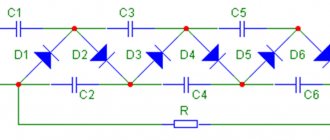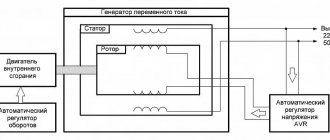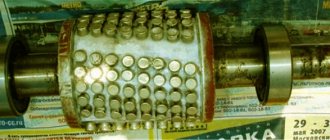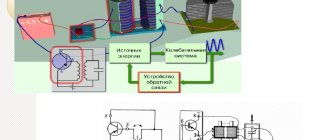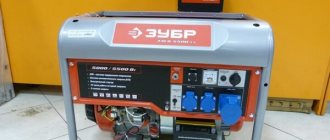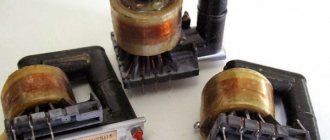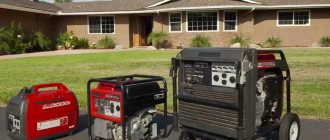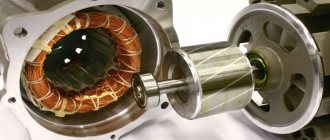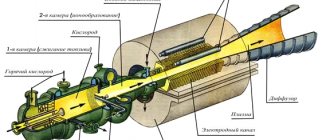All about electric generators and power plants
When a gasoline generator produces low voltage at idle or under rated load, it is necessary to identify and eliminate defects in the gasoline generator as quickly as possible in order to minimize the damage from malfunctions at an early stage of the breakdown.
One of the most common reasons why the generator does not produce voltage or produces low voltage during normal engine operation is simple oxidation or burning of the contacts of the power wires, machine or socket at the output of the gas generator. Such defects occur when equipment is stored for a long time in unfavorable conditions or when the generator operates under harsh conditions at loads close to maximum.
What needs to be done: use a multimeter or tester to check the voltage at the output terminals of the generator - from the terminal box of the generator itself (the thickest wires) to the outlet. To check the entire output circuit, you may have to open the protective cover or even open the generator control panel with a screwdriver. If no traces of corrosion or burnt contacts are visually visible, use a device along the entire circuit to look for the place where the voltage sags. The most painful places are the contacts on the socket, the fuse box, as well as the burning of the circuit breaker on the control panel. Defective areas must be cleaned and re-soldered efficiently. Replace burnt wires or the circuit breaker with new ones or known good ones.
Low voltage, and power circuits are working.
If the output power circuits are working properly, and the gasoline generator still produces low voltage, you should proceed to the next step - diagnosing the AVR generator voltage regulator. Diagnostics should again begin with a visual inspection of the voltage regulator unit. If burn marks are clearly visible on the AVR unit or if the capacitor is clearly swollen, then with a high degree of probability the reason for the absence or low voltage of the generator is hidden here.
What needs to be done: replace the voltage regulator unit with a new or working one. If you do not have the opportunity to purchase or borrow at least temporarily a known-good voltage regulator, you can read how to repair the AVR yourself using improvised means.
Troubleshooting procedure
Checking the gas generator for serviceability and diagnosing the electrical part is carried out with the external line disconnected. That is, the wires connected to the output terminals are discarded.
Voltage rating measurement
It doesn’t “give off tension” – the concept is quite vague. It is necessary to check whether there is at least some voltage at the output terminals, or whether it is completely absent. What will it give? First of all, the presence of a denomination, even a greatly underestimated one, indicates that there are no obvious breaks in the scheme. Such preliminary diagnosis greatly facilitates solving the problem.
If the generator ATS is working and the voltage is still low.
If, even after replacing the voltage regulator, the gas generator still produces low voltage, then you most likely have the most unpleasant type of breakdown - an interturn short circuit of the generator windings. You can finally verify this by ringing the windings with a multimeter or tester.
What needs to be done: you need to rewind the generator stator. If your engine's service life has not yet been exhausted, it may be economically feasible to buy a new generator. In Chinese online stores you can very inexpensively purchase an alternator of the required power for mere pennies.
I would like to dwell separately on the issue of purchasing serviceable spare parts for your generator. Since the most problematic and expensive part of a gas generator is still the internal combustion engine, there are quite a lot of offers online to sell gasoline generators that have problems with the engine or fuel system inexpensively or even very cheaply. Do not ignore such advertisements if someone is selling a faulty gas generator of the same model as yours. If your gas generator does not produce the nominal 220V or 380V at the most inopportune moment, then such a donor - a gas generator, from which you can rearrange the necessary part in a few minutes, can help you out a lot, reducing the time and cost of repairs to a minimum!
We hope that our article helped you, and you can now figure out on your own what to do with a gas generator if the generator produces low voltage at idle or at rated engine speed.
We remind you that using the necessary spare parts for a gasoline generator and a kit for running on gas, you can independently convert the gasoline generator into a gas generator with the ability to run on gasoline.
Many people have a need to provide their home with an uninterrupted power supply system - the quality of domestic electricity supply is low, which is especially typical for suburban and rural areas. The most common solution is to purchase a gas generator - these devices are available in a wide range and have an affordable price. However, a gas generator, being a rather complex device, has many features, the knowledge of which is necessary for every owner to properly use such equipment.
What causes malfunctions?
Conventionally, a gas generator consists of two blocks: an engine and an alternator. All other equipment that may be present on a gas generator are systems that complement the first and second parts, or units that expand functionality. Most often, gasoline generators are repaired for the following reasons:
- Poor quality parts or workmanship
- Violation of operating rules
- Late service
- Result of normal wear and tear
Each gas generator is equipped with an instruction manual, which describes in detail the technical features of the product, requirements for the conditions in which the device will be used, operating rules, and a table-calendar of maintenance work. Strict adherence to the instructions in the operating manual allows you to minimize the risk of malfunctions over a long period of time.
Lack of oil, fuel, air supply
If the engine does not start or stalls, this means that the protective system has responded to the following factors:
- Lack of fuel - Even if gasoline is present, the fuel filter may be dirty.
- Lack of air - the air filter needs to be cleaned.
- Lack of oil - check its level.
Also, evidence of a breakdown may include smoke, exhaust of an uncharacteristic color, a sharp decrease in power, overheating, uneven operation of the gasoline generator, and increased oil consumption. These symptoms may be the result of wear of the piston rings, piston, cylinder, or violation of the internal geometry of certain elements. With such symptoms, high-quality diagnostics and repair of the gas generator engine is necessary.
Checking the fuel supply
In order to check whether gasoline is entering the cylinder, you need to unscrew the spark plug and look at its electrodes. If the spark plug is dry, then gasoline apparently does not flow, but if it is wet, then it does.
Sometimes it happens that the spark plug is “flooded” with fuel during starting. That is, there seems to be a spark, but for some reason it was not possible to start the engine right away, and at the same time gasoline flowed while pulling the starter, the spark plug became damp and the spark no longer breaks through the fuel at the electrode. In this case, the electrodes can simply be wiped.
Problems with the ignition system
The spark plug fails for several reasons: an increase in the distance between the electrodes due to natural wear, mechanical damage to the spark plug. In such cases, the spark plug will have to be replaced. Coking of the electrodes is a consequence of working with low-quality or old fuel, as well as suboptimal engine loads. The coked spark plug must be unscrewed and the electrodes thoroughly cleaned. Another reason for the engine not starting may be a loose spark plug cap.
Malfunctions associated with the operation of the electric generator
Most often, a gasoline generator in the budget and mid-price segment is equipped with a brush synchronous alternator, which copes well with the imposed loads and is relatively cheap. However, it has some disadvantages:
- The need to periodically replace brushes
- Sensitivity to dust and high humidity
Untimely replacement of brushes can damage the entire alternator, which will entail additional costs. Alternator failure can also result from operating the device in polluted conditions.
The cause of a malfunction of a gasoline generator may be wires that are subjected to mechanical and temperature influences during operation - loss of contact, short circuit, chafing, rupture. Diagnostics and repair of electrical wiring must be carried out by qualified specialists.
The gas generator works intermittently
A malfunction of the regulator is signaled by a situation when the revolutions of the gas generator fluctuate under load, and there are interruptions in starting a cold and hot engine. If measures are not taken, the situation will be aggravated by premature wear of internal components and failure of the device.
Adjusting the frequency of a gasoline generator can solve the problem, but it must be done correctly. The work will require a tester for measuring frequency and a long screwdriver with a Phillips head. Compliance with the given algorithm of actions will allow you to perform power plant maintenance quickly and safely:
- The first step is to disassemble the carburetor to gain access to the fuel jets. Then, using a compressor, carefully blow out the jets, channels and emulsion tube.
- The next task is to find the quantity screw and set the throttle valve so that the minimum gap value is 1.5 mm. Upon completion of the manipulation, the output parameters are checked. The value should not go beyond the range of 210-235 V. It is optimal to achieve a balance between the number of generated revolutions and voltage.
- Next, you need to work with the mixture quality screw to eliminate interruptions during idle. It is found in a special hole, screwed until it stops, and then loosened two or three turns. During the adjustment process, make sure that the device operates without problems during a cold engine start or at idle.
Gasoline generator does not produce voltage
In case of problems with the electrical system: the gas generator does not produce 220v voltage, the user will learn how to correct this situation from the current section. Most often the problem occurs due to wear on the brushes. If self-diagnosis confirms this theory, in order to restore the functionality of the power plant, the brushes are removed, the degree of wear is assessed and replaced with new consumables.
The work will require a screwdriver, since the user will need to set the pressure spring on the brushes. After completion of the service, the device is assembled and a test run is carried out. The frequency of brush replacement is determined by the intensity of use of the device to generate current.
The gas generator produces low voltage
Due to oxidation or burning of the machine contacts, power drives or outlet sockets, the gas generator in use does not hold the load or produces low voltage. Situations often arise when the device is turned on in harsh conditions and the engine is running at maximum loads.
The user can correct defects as follows:
- The voltage at the terminals is checked using a multimeter.
- If the inspection does not reveal the presence of burnt contacts and traces of corrosion, you need to check the entire circuit and find areas where, according to the tester, the voltage sags.
- Identified areas with defects are cleaned and soldered. Burnt wires and faulty circuit breakers are replaced.
Reasons why a gas generator may not produce 220 volts
We will send the material by email
I recently went out to order, for which I took my old gas generator with me. During the process, his voltage dropped sharply, and after that he did not produce 220 volts. Since I did not have the equipment necessary to check the serviceability of the gas generator with me, I returned to the workshop, where I began a full diagnosis of it. And then I’ll tell you about possible breakdowns and malfunctions of the gas generator, due to which the generator may not produce the required voltage.
The gas generator stalls after starting
Does the device’s engine stall immediately after starting, and its startup is accompanied by uncharacteristic sounds? The cause of the breakdown most likely lies in a malfunction or contamination of the spark plugs. Replacing them or cleaning them from carbon deposits are the simplest operations that every home craftsman can perform on his own.
There is no need to contact a service center even if the power plant motor stalls due to incorrectly adjusted clearances. Armed with a screwdriver, the master will have to bend the candle petal to the optimal distance, and then make sure that a spark will jump between the elements.
What kind of work can you do yourself?
Almost all typical gas generator malfunctions and methods for eliminating them are prescribed in the instructions for use. Manipulations that the user can carry out independently:
- Cleaning filters
- Filling oil
- Fuel replacement
- Replacing and cleaning the spark plug
All other actions involve penetration into the internal structure of the gas generator. Such work can only be performed by certified specialists. Even if you have certain skills, you should know that repairing a gas generator with your own hands entails loss of warranty from the manufacturer and, as a result, unnecessary costs.
Idle speed instability
Causes and solutions:
- Low number of idle revolutions per unit of time (adjusting the number of idle revolutions)
- The idle jet is clogged (check followed by cleaning)
Intake system malfunction
- Air enters the intake manifold (tightening or replacing the gasket)
Cylinder head failure
- Loose fit of the gasket, leading to gas breakthrough (replacement of the gasket)
- The valve clearance differs from that specified for this model (adjustment of the clearance is required)
- Valves are not tightly closed (adjusting valve closing tightness)
- The gap between the guide sleeve and the valve stem is too large (valve replacement required)
Ignition system malfunction
- Spark plug produces weak spark (spark plug needs to be replaced)
Where do quality equipment repairs take place?
Due to its operation, the gas generator periodically requires maintenance and, if necessary, repairs. Our company carries out diagnostics and repair of gas generators, as well as their scheduled maintenance. Personnel regularly undergo all necessary certifications at official representative offices of manufacturing plants. Repairs and diagnostics are carried out using modern equipment in a short time. By contacting us, you entrust your equipment to the best specialists.
Over time, even the most reliable and high-quality equipment can malfunction (cause the gas generator does not start). The gas generator is no exception. There can be many reasons for this. Most owners begin to panic and turn to specialists for help, but in fact, some problems can be fixed on their own, so to speak, at home. In this article, we will tell you what reasons there may be why a gasoline power plant does not start, and how you can deal with it.
There may be several reasons why it won't start. So, let's look at the possible reasons why the gas generator does not start at all or why when it starts, it immediately “stalls out”. The three main components on which the operation of a carburetor engine rests are gasoline, air and spark. You probably already guessed that we need to check these three devices that are necessary for the engine to operate properly.
1. Lack of gasoline in the tank
The owner of a gas generator may incorrectly calculate the required amount of fuel or simply forget to fill the fuel tank. First, you need to check the path (through which fuel is supplied to the carburetor). Secondly, the gasoline mixture may be outdated, that is, it has lost its octane properties. What can be done? Pour fresh mixture into the fuel tank and try to start the generator again.
It is important to remember that there is a tap on the tube under the gas tank. So, you need to carefully ensure that it is open.
3. Fuel hose
Need to check if it is leaking? If it leaks or becomes unusable, replace it.
The generator may not start because there is no spark.
What to do? First you need to unscrew the spark plug, check its condition, the presence of a spark, and if necessary, replace it with a new one. If the spark plug is filled with fuel mixture, it must be unscrewed and dried. Carbon deposits on the spark plug - clean it with an awl or needle; the electrodes can be cleaned with sandpaper. If there is heavy carbon deposits, replace with a new one. A dry spark plug means that there is a problem with the fuel supply to the cylinder. If there is a spark and the generator does not start, most likely there is no fuel in the carburetor. Another reason why there is no spark is a possible sticking of the oil sensor.
If there is no spark, pay attention to the oil level sensor
Read more about the oil sensor and the oil itself.....
In generators, especially inexpensive ones, the oil level sensor may malfunction, and this is often the reason the engine stops. In such a situation, it is necessary to check whether the sensor is working, whether there is oil in the crankcase and, if necessary, replace it. — It’s important to remember! It is a very big risk to disconnect the oil level sensor, since this is engine protection. — If the automatic oil level control system is triggered, then you need to check the oil level and, if necessary, top up.
5. Air filter
The next possible reason why the generator does not start may be a dirty air filter. An unclean filter prevents the passage of the amount of air necessary for fuel combustion. What can be done? Remove it, wash it or clean it thoroughly, dry it, then put it back in place. Important to remember! When starting the device, the air damper must be in the “closed” position.
If the engine fails to start, then we check the fuel system.
Troubleshooting procedure
Check the gas generator for serviceability or diagnose the electrical part of the equipment only when the external line is disconnected - make sure that the wires are not connected to the output terminals, otherwise discard them
Voltage rating measurement
The very concept of “Doesn’t show tension” is very vague. Therefore, the first thing you need to do is check whether there is at least some voltage or whether it is completely absent. This first of all gives the presence of a nominal value, even if it is greatly underestimated, this indicates that there are no serious breaks in the circuit. Such a primary diagnosis greatly facilitates solving the problem.
Visual inspection of the device
Any repair of technical equipment, regardless of the type of breakdown, should begin with this. Look at all the parts, elements and circuits of the gas generator that are in sight. If your unit vibrates during operation, then, as a rule, most of the faults are related to the contacts, or more precisely, to their weakening. The solution is very simple - after checking the reliability of all connections, including the electrical part, carry out a “tightening” if necessary, but it won’t hurt for prevention.
Generator check
The generator is an electric motor that generates voltage that is removed from the windings during forced rotation of the shaft. It will not be possible to repair the generator yourself without the necessary tools, but diagnostics can be done. To do this, you will need at least a simple multimeter - if it does not produce voltage, then it should already be clear where the breakdown or malfunction is.
Source technocube.com.ua
Checking the condition of the current collection brushes
Some models of gasoline generators have current collecting brushes, and one of the typical faults for these models is the breakage of one of these brushes. Therefore, you need to check the integrity of the windings. To do this, it is quite enough to disconnect one of the terminals of the winding, and then “test” it. If after checking with a multimeter there are several ohms there, then everything is in order.
Only a professional can diagnose a case of rotor demagnetization. So it's just a matter of going to the workshop for a check.
Source ad-cd.net
Checking the electrical circuit
If the generator is working properly, and the voltage is removed from its windings, which is then supplied to the electronic unit, but there is some kind of breakdown, then it is necessary to find the area where the voltage disappears. When measuring alternating voltage, you need to check the test points with a multimeter probe.
You will have to determine these points yourself, taking into account where it will be most convenient to take the measurement. Thanks to this technique, you can not only find the location of the circuit break, but also the faulty radio component in order to replace it.
Load check
Each gas generator is characterized by its own specific electrical power: if several consumers are connected to the power line, then with an increase in the total value of their respective parameters, the device may simply not produce voltage. The reason for this is the activation of the protection circuit (shutdown).
This is very easy to check: if the voltage at the output of the gas generator in stand-alone mode is normal (not too low or “jumping”), but after connecting the external line some malfunctions appear, then the load on your device is greater than the maximum permissible.
Source ichip.ru
I recommend the following video, in which the author talks about possible reasons why a gas generator may not produce 220 volts:
The main malfunctions of a gas generator and their causes.
Gasoline generator engine malfunctions
The gas generator won't start
Or it starts but stalls.
This is a fairly common problem. Several factors influence this: spark, fuel supply, gas distribution mechanism, major mechanical damage
(such as a hole in the crankcase or a broken connecting rod).
spark
due to a burnt coil, cap or spark plug.
It is also possible that the sensor relay or oil sensor may fail (cuts off the spark when the oil level is low), and faulty wiring components are also possible. The fuel supply
is disrupted, the fuel system (carburetor, tap, filter, gas tank) is clogged, system elements (carburetor, tap, fuel pump) are faulty.
Long downtime of equipment is detrimental to the fuel system. The timing belt
is responsible for gas distribution; large gaps and carbon deposits on the valves prevent the engine from working efficiently and sometimes even starting.
The engine is smoking.
The main reason is the exhaustion of the piston group; oil from the crankcase enters the combustion chamber (the piston and cylinder are worn out). Too much oil also produces smoke.
The engine is knocking.
Production of crankshaft, connecting rod, bearings.
Engine wedge.
Also due to oil starvation there is strong production and carbon deposits in the combustion chamber.
Gasoline in the crankcase.
Gasoline and oil are leaking from the crankcase. The carburetor is faulty, most likely the needle does not hold. Causes include wear or dirt in the carburetor.
Malfunctions of the electrical part of the gas generator
The gas generator does not produce current.
The engine starts normally, but there is no current. The reasons are trivial: the AVR burned out (the generator does not excite), faulty diodes, problems with electrical wiring, problems in the stator or rotor, and also individual modules fail (on some generators). On inverter generators, the main fault is the inverter board.
The gas generator produces current, but it is too strong or weak
The connected devices do not work or are burning. There are two reasons: the engine does not operate at 3000 rpm (3000 rpm).
220 volts), faulty electronic components (automatic transfer switch, inverter board, capacitors, diodes)
When connecting devices, the engine stalls or does not turn on
— again a problem with the engine. Something is clogged or not adjusted.
What is a gas generator
Gasoline generators can be considered mini power plants. The principle of their operation is to burn fuel and convert its internal energy into electrical energy. The components of a gas generator are an internal combustion engine and an electric generator itself.
One of the types of gasoline generators is inverter gasoline generators. Their difference is the presence of an inverter and a PWM unit (pulse width modulation).
Like any equipment, generators can also break down. Below I will talk about several of the most common causes and troubleshooting methods that may cause the generator to not produce 220 volts.
Troubleshooting basic gas generator problems on your own.
The basic principle of repairing any equipment is eliminating faults by elimination. How we do it. The generator comes to us and we begin to check:
- First of all,
we inspect the appearance for mechanical damage and oil leaks, as well as the presence of rust in the tank. Next, check the presence of oil and crank the engine with the starter (check the compression resistance and extraneous noise). Let's try to start it. - If not, look for a spark
. We immediately take a new spark plug (leaning the spark plug against ground and cranking the engine), if there is no spark or it is weak, we try to disconnect the wires from the oil sensor relay and replace the spark plug cap. If it doesn't help, look at the ignition switch or power button. If everything is fine there, then the ignition coil is faulty. - If there is a spark
, we try to start it. If it starts and stalls or runs with the choke closed, the carburetor is definitely clogged. Many people say that they cleaned it themselves, but the symptoms are the same. This is obvious; you need to clean the carburetor by disassembling it down to the bolt using special means. And that’s half the battle, then you need to install it and correctly adjust the rods and springs of the damper and speed controller. If it does not start at all, add a little gasoline to the combustion chamber, through the spark plug hole or an open carburetor choke. - Rust in the tank
is a very annoying problem, you can clean the fuel system and everything will work. But soon, after some time, this rust will get into the carburetor (into the jets, under the needle) and the symptoms will repeat. If there is rust in the tank, it is almost impossible to remove it. You can pour special agents (such as solvent) into the tank overnight or install a fuel filter, but the only salvation is to replace the tank.
Any technology begins to fail over time. This can happen for many reasons. The gas generator may also stall, or the diesel unit may stop working.
A gas generator is a device that converts thermal energy into electricity. The unit consists of two main parts - the engine and the electric generator. The engine drives the generator shaft, which produces a certain voltage.
What kind of oil should I put into Fubag generators?
- Fubag Extra (SAE 10W40))
- Fubag Practice (SAE 30)
For Fubag power plants, it is recommended to use branded oil, which is ideally matched to Fubag engines.
2) Maintenance and replacement of the air filter
The air filter cleans the air that enters the carburetor, where it mixes with fuel.
During operation, the filter gradually becomes dirty. A dirty filter worsens the quality of the fuel mixture, increases its consumption and leads to accelerated engine wear.
In Fubag generators, access to the filter is very simple:
— Unfasten the latches of the filter housing
— Remove the air filter, assess for contamination
— Clean the dirty foam filter with kerosene and dry it
— Install the filter element between the grille and the filter cover in its original place
If you are preparing the station for wintering
, then it is recommended to moisten the filter with engine oil - then it will not freeze in winter and will retain its elasticity.
The filter must be checked before each start. It needs to be cleaned every 50 hours. Change every 100 hours.
Some manufacturers also use paper filters. For obvious reasons, such filters cannot be washed. They are subject to replacement.
Important:
Never run your generator without a filter!
3) Replacing the spark plug of the generator
The procedure for replacing the spark plug is necessary and simple.
The spark plug is checked every 50 hours and cleaned if necessary. The generator passport contains a detailed description of the procedure.
How it's done:
— Remove and, if dirty, clean the spark plug cap
- Using a spark plug wrench, unscrew the spark plug
— We inspect the insulator, if there is a crack on it, then the spark plug needs to be replaced
— Using a special probe, we measure the gap between the electrodes. The norm for it is 0.7-0.8 mm. If the values differ, adjust to the desired value (bend or bend the electrode)
— If the spark plug is carbonated, you need to clean it with fine sandpaper or a special metal brush
— We install the candle in place manually so as not to distort the thread and put on the cap
If you are using a new spark plug, then after tightening it by hand you need to tighten it half a turn with a wrench.
Important Note:
For the Fubag gas generator you can use spark plugs of different brands.
Some manufacturers recommend using only their own candles. But that's not true. Candles are a popular product of the same type, and any seller will recommend you a dozen brands of good candles.
4) Inspect the fuel filter at the generator
It is recommended to periodically inspect and clean the generator fuel filter.
The fuel filter prevents dirt and foreign particles from entering the engine tank and increases the quality of operation and service life of the power plant.
The fuel filter on the TI 2600 inverter power station is located directly behind the gas tank cap.
How it's done:
— Remove the fuel filter cover.
— We clean it from water and dirt.
— Clean the grille and fuel filter cover with gasoline.
— We tightly connect the filter parts and install them in place.
As you can see, the maintenance procedure for the Fubag gas generator is simple and does not take much time. By following it, you will help your generator work for a very long time and without breakdowns!
Why does the gasoline generator not start?
Periodically, the gas generator refuses to start. There may be several reasons for this, each of which has its own solution.
There is no gasoline in the tank.
A person may forget to fill the fuel tank, or incorrectly calculate the required amount of fuel. Particular attention should be paid to the motor that powers the unit. It is necessary to add both gasoline and oil to the tank, which is necessary to lubricate the various rotating and rubbing parts of the generator. During inspection, it is necessary to check the path through which fuel is supplied to the carburetor, in addition to the engine cylinder. You should also make sure that there is enough oxygen supplied, otherwise the gasoline will not burn.
Formation of condensation in the fuel tank.
The appearance of condensation is inevitable with significant temperature changes and high humidity. To solve the problem, you need to drain the fuel and dry the tank, for which you should leave it open for a while. After 4-5 hours, the gasoline previously drained from the tank will have settled sufficiently.
No spark in the spark plug.
This is easy to check - just unscrew the spark plug and touch the metal body of the engine with the electrode. The spark plug must be held by the insulator; according to safety requirements, other parts of the spark plug cannot be touched. If there is no spark, this means either the spark plug is worn out or the supply wire needs to be replaced.
Acid battery discharge.
Some models have it, others don't. In models where it is provided, it ensures the operation of the starter, as well as the ignition. A lead acid battery must be charged periodically.
Problems with the fuel pump.
The fuel hose is disconnected. When the engine stops, it must be cranked 2-3 times with the starter. A stream of fuel should appear on the fuel hose, which is supplied under pressure. If there is no jet, the fuel pump needs to be repaired.
Other faults
Causes and solutions
The muffler fires during the factory, and the fire is visible
- Faulty spark plugs (change spark plugs)
- The mixture in the cylinders does not burn completely (cleaning or replacing air filters)
- Problems with the exhaust valve (incomplete closure, wear, burnt seat); burning mixture entering the muffler (check that the carburetor settings are correct)
- A flash in the muffler occurs due to the knocking down of the valve opening angle, or the knocking down of the ignition angle when the spark plug flares with the exhaust valve slightly open (check the degree of tightness of the valve to the seat; make sure that the valve timing and ignition timing are set correctly);
A minute after starting and warming up, the gas generator stalls, while gasoline flows normally and the air filter is not dirty.
- Not enough oil (add oil to the level indicated on the label)
In a practically new generator, when it is put into operating mode, there is no current
- Excess starting current, i.e. connection to the generator of devices that require more energy when starting up than the generator produces
A gas generator with a service life of 1 year has gasoline leaking from the air filter.
- Clogging or oxidation of the carburetor (if clogged, the carburetor must be cleaned; if oxidized, replace it)
The engine hour sensor does not work (replace the sensor)
When the generator was operating above the permissible power, the voltage was lost, but the engine was running properly
- Burnout of diodes or windings (replacement of failed elements)
The gas generator stalls a minute after starting; this goes on all the time
- Lack of fuel (check fuel level)
- Before putting the gas generator away for winter storage, the fuel was not drained (replacing the carburetor)
Why does a gasoline generator not produce voltage?
Sometimes a situation arises when a gasoline generator is working, but the output voltage is not enough. There are many reasons, some of them may include the following:
Weak compression. Including:
- Spark plugs are not tightened properly.
- Worn cylinder, piston, piston rings.
- The piston rod is stuck.
- Worn cylinder head gasket.
All problems can be solved by repairing or replacing the necessary parts. In some cases, simply tightening the bolts more tightly is enough.
Ignition problems.
- If necessary, you need to replace the coil and spark plug.
- If the air gap between the coil and the flywheel is not up to standard, it will need to be adjusted.
- If the magneto becomes demagnetized, it must be replaced.
The engine does not gain the declared power
There may be the following reasons, with recommendations for elimination:
- The spark plugs are not tightened enough (to fix it, you need to either replace the spark plug gasket or simply tighten it).
- The cylinder head does not fit tightly (in this case, simply tighten the fastening bolts more tightly, or simply replace the gasket).
- Piston rings are worn or seized (replace rings).
- The cylinder or piston is worn (repair or replace).
- There may be poor contact between the working chamfers of the valve and the seat (either repair or replace).
- The piston rod is stuck (again, replacement or repair).
- The size of the gap between the valves may differ from the specified gap size of this model (to eliminate this, you need to adjust the gap size).
Problems in the ignition system
Ignition system malfunctions:
- The spark plugs may be faulty (just replace the spark plug).
- Ignition coils are faulty (replace coils).
- The air gap between the flywheel and the ignition coil differs from that provided by the manufacturer for this model (adjust the gap size).
- The magneto may be demagnetized (replace the magneto).
Problems with the fuel system
Fuel system malfunctions:
- Clogged carburetor (to remove it, disassemble and clean the carburetor itself).
- Clogged hose or filter (clean the hose or simply replace it).
- Air may enter the fuel hose (all connections must be checked and adjusted).
- Another problem may be low quality fuel or it is diluted with water (use higher quality fuel).
Weakness of air flow
Air duct problems:
- Clogged air filter (clean or replace the filter itself).
- The fuel choke may be faulty or broken (repair or replace it).
